India’s First Digital Election Campaign
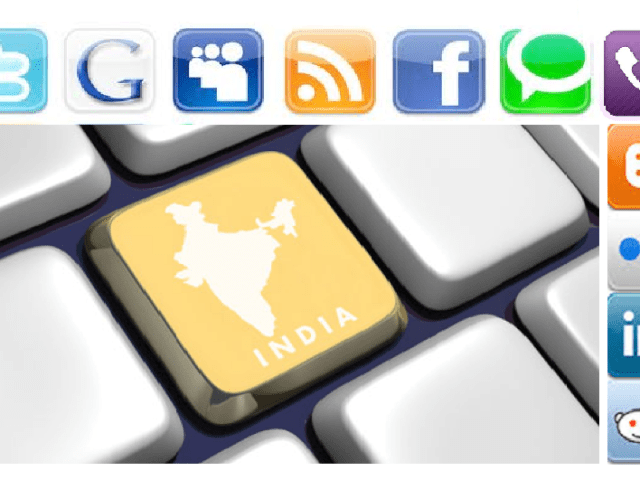
SB Veda
During the run-up to the 2011 state elections in West Bengal, the uniform cacophonic layer of howling busses, beeping horns, and running voices, permeating the air was regularly pierced by the boom of loudspeakers, sometimes fixed to lamp posts, sometimes to the top of vehicles, four, three and two wheelers alike. The ostensible purpose of these rude interruptions, blaring across the landscape, was for political announcement, to campaign for a candidate, extoll the virtues of a party leader, more often to decry the failings of opponents; to many, the real intent was demonstrate the might of the party machine to the lowly citizen.
Today, the party machine has gone digital: the streets are relatively quiet as a new type of campaign, one that will be won or lost in tweets, likes, and hits as bits of data are flung to and from servers, which copy, amplify and disperse them en masse to the public. This is electioneering in the information age – a flurry of quiet canvassing done through clicks and taps on electronic devices. It is evidence of a newer republic emerging from the still young country of India, born on the stroke of midnight on August 15, 1947.
Midnight’s children, those born at the moment India became independent, whose powers and failings Salman Rushdie so magically narrated in his Booker Prize winning novel of the same name, have aged; their voices have grown hoarse; their bodies have become frail; and their powers are weakening. It is their children, ‘morning’s babes’ we could call them, done with their crying and carefree upbringing, are speaking at last, asserting themselves, articulating the issues that frame the way forward for their families, their offspring. The politicians, even the old guard, pre-midnight, those born before independence, are listening – and learning.
One recent Sunday morning, The Washington Post reported on volunteers from the Bharatiya Janata Party (BJP), which is the main opposition party, fanning out across middle-class neighborhoods in the nation’s capital, making their way through, one apartment building at a time. Knocking on doors and guided by the most sophisticated set of analytical voter data that India has ever seen, they represent the new generation of party worker, educated, urban, and subtle.
When a sleepy young man at one door said he favored the party’s candidate for prime minister, Narendra Modi, the volunteers pounced.
“Are you on Facebook? Twitter? Do you use WhatsApp to chat with friends? We would like to send out some political jokes, Modi messages and videos. Can you post and circulate them among your friends?” asked Mahavir Mittal, 45, an English speaking business owner, one of a new breed of election volunteers deployed on the streets.
On Monday, millions headed to the ballot box in the first phase of the largest election in history, which could oust the party that has dominated India’s politics for decades and see the voters move beyond what it has casted as traditional priorities such as caste and religion, to focus on government corruption and the economy.
India’s electorate is starkly different today compared to voters a decade ago, when Congress Party Prime Ministerial Candidate, Manmohan Singh first headed a coalition government, the United Progressive Alliance, which has ruled India since. About two-thirds of the population is younger than 35. Voters are more urban and vastly more connected than ever before. Upwardly mobile urban dwellers make up about one-third of the electorate. And these young movers and shakers, headphones on, eyes on their handhelds, have no patience for old-style politics.
To reach them, political parties are going beyond the traditional campaign rallies, packed with supporters bussed in by candidates. Now, they are pursuing U.S.-style campaign strategies, including volunteer mobilization, social media outreach and micro-targeting of various groups — such as business executives, students and retirees living in secure communities. The parties hope to engage members of India’s growing middle class who, in previous elections, stayed home instead of waiting in long, chaotic lines at polling stations.
It is the BJP, who are the most attuned to this strategy. In 2004, voter apathy is what was attributed to the surprising defeat of a popular incumbent BJP-led coalition government. With a polarizing septuagenarian Prime Ministerial candidate fielded in 2009, they fared no better.
“They couldn’t mobilize their base.” Says Sumeet Kumar, a retired political scientist, observing the election in India in 2014. “They don’t want to repeat this mistake, especially when the Congress government is riddled by scandal, and there is such an anti-incumbent feeling.”
The tactics are also targeting India’s youth, which, if taken as a block would surely swing the election. The number of first-time voters has increased from 43 million in 2009 to 101 million, out of 814 million eligible voters, according to the Election Commission of India.
In the past, voters often cast ballots along caste, religious or ethnic lines, sometimes following a village elder’s orders. This benefited the governing Congress party, which has a large presence in the countryside.
“I am impatient. Some days I feel that our old-style politics and politicians will never change, but then there are days when I feel there is still some hope for India,” said Tavleen Kohli, 22, a graduate student of psychology in Gurgaon, a suburb of the capital. “Jobs are important for me, but so is clean politics. In this election, many of my friends feel that our vote matters.”
Siddhant Gupta, 19, a communications major at ILEAD College, Calcutta, agrees. “I’m the least political person around but even I get lots of messages via Whatsapp on politics, and it really draws you in. There are a lot of people my age who’ve become politically engaged because of this”
New Voters, New Leaders, and New Strategies
Modi, 63, has 3.66 million followers on Twitter and has drawn more than a million volunteers to his campaign, a new development in a country where politicking has generally been done by party workers, called cadres. His Bharatiya Janata Party is ahead in most polls.
His campaign highlights his record as the pro-business chief minister of the western state of Gujarat and plays down his credentials as a Hindu nationalist. He is trying to capi¬tal¬ize on disillusionment with the current government over the slowdown in economic growth, after the UPA government inherited a booming economy from the BJP-led National Democratic Alliance. The country’s gross domestic product grew at more than 4 percent in 2013, less than half of the increase in 2010. It has been a huge disappointment for those who had forecast 2020 as the year when the seeds planted by the economic reforms of the 1990s will bear fruit. They are frustrated with having to recalibrate due to the ironic mismanagement of economy by the very Prime Minister, who had initiated the reforms in the first place, when he was Finance Minister under Prime Minister P.V. Narasimha Rao, perhaps the most historically significant Congress Prime Minister, outside of the Nehru-Gandhi clan.
For the past Sixty-Seven Years, a descendent of this rich barrister, Motilal Nehru has ruled India as Prime Minister for some forty years, beginning with son, Jawaharlal in 1947. Though none of the ‘first family’ holds any ministerial position in the UPA government, it is quite evident to all that since 2004, the balance of power has been held by the Nehru-Gandhi family (named for the fact that Motilal’s grand-daughter Indira, Prime Minister, herself for fifteen years before her son, Rajiv inherited the mantle, married a Congress political worker named Feroze Gandhi).
Sonia Gandhi, Rajiv’s widow had been tapped to become Prime Minister after the Congress Party, which won the most number of seats in the 2004 election formed a government with the support of an alliance of left leaning parties. She declined to take it, many say due to security concerns (hailing from Italy, her past is mysterious and has been cannon fodder on the internet, since). When former Finance Minister and Harvard educated economist, Dr. Manmohan Singh was selected by the Nehru-Gandhi family and its sycophants (also known as the Congress ‘High Command’) to lead, India Inc. was elated. After all, the Congress High Command had claimed during the campaign that the BJP led government had only continued Dr. Singh’s economic policies during their tenure. As actual architect of those reforms, Singh would be best poised to build on them, make the economy more open, free, cut-out red tape, inject into the engine of growth, the lubricant that could get the machinery of government to operate more efficiently.
As Singh increasingly drew his marching orders from Sonia Gandhi, the General Secretary of the Congress Party and her populist inner circle, it became clear that Dr. Singh was only a figure head. Under Dr. Singh’s official watch but Sonia Gandhi’s actual leadership in her role as Chair of the UPA, the government turned away from the reforms of the 1990s, backing down from implementing foreign direct investment in various spheres, abdicating the decision making power, fobbing it off on the individual state governments. Being populist and even more corrupt than their counterparts in the Central Government, most opted not to follow through. Growth slowed, sputtered, and it left many hankering for a change.
Enter Narendra Modi. Born in independent India, a generation removed from Dr. Singh, the young dynamic Chief Minister of Gujrat is almost singlehandedly credited by his supporters for the miracle of his state’s economic rise during his tenure. But his critics say there is nothing remarkable here except that Mr. Modi has been a competent manager –he reviews data, assimilates it, and takes decisions. He has shown a capability to get things done at a time when his peers in other states have demonstrated only their power to oppose. Modi’s volunteers are cut from the same cloth, running war rooms in three cities, with social media and speechwriting teams that can fine-tune his message for specific groups.
Indian campaigners don’t have access to the vast array of consumer data that American political parties use. But Modi’s campaign analysts spent months creating a database with polling information from individual precincts in the past six elections, which had to be translated from dozens of languages to identify and target potential voters.
When Mittal was canvassing in central Delhi, he was armed with voters’ telephone numbers, e-mail addresses, the neighborhoods’ past voting records and an estimate of how likely individuals are to vote for Modi.
The volunteers “are the young, middle-class professionals who want to contribute, but they are not here for a lifetime. They have attached themselves to us for a few months,” said Arvind Gupta, the head of the BJP’s digital campaign. “We have studied [President] Obama’s election campaign strategies and observed the elections in Australia. We are taking best practices, but we are also Indianizing it.”
For example, the campaign encourages supporters to place a “missed call” of support with their cellphones as a way to generate a telephone database. The missed call is a common phenomenon in India; people ring a number and then hang up so they are not charged for the call but the act leaves a reminder that they telephoned. In this case, the campaign can text or call them back with information.
Late last year, the new Aam Aadmi Party, or Common Man Party, surprised many people with its strong showing in the Delhi state election, just a year after it was founded on an anti-corruption platform. Although its Delhi government quickly imploded, many credited the party’s fast rise to its use of Obama-style tactics such as volunteer canvassing and raising funds from small donors. Since then, the party has raised nearly $3.5 million from smaller donors in amounts as modest as 10 rupees (about 17 cents).
“We were a social movement before we became a political party. We set the benchmark on the use of social media for mobilizing volunteers around an idea of anti-corruption,” said Dilip Pandey, who supervises the campaign for AAP.
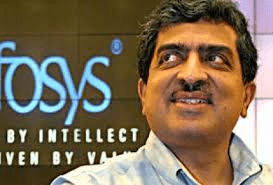
Infosys Co-Founder turned politician, Nandan Nilekani
While by enlarge, Congress has shown a lack of originality in their ideas and leadership, positioning Sonia’s son Rahul as PM in waiting (whether that PM stands for Prime Minister or Puppet Master) Nandan Nilekani, co-founder of global IT giant Infosys, who is running for a seat in Parliament as a Congress party candidate stands apart. His use of micro-targeting to woo voters in the tech hub of Bangalore is a first for the Congress. His team created an app that helps his volunteers keep track of each family’s political leanings and how they change.
But he says there are still limits to how widely Western-style strategies can be used in India, given that just about 200 million people — less than 20 percent of the population — have Internet access.
“What works is how Obama harnessed volunteers, how to target messaging and communication,” Nilekani said. “What does not work is that the quality of voters’ database in the U.S. is much higher, much more digitized — like voting records, credit-¬history records, ability to deduce a person’s political affinities. There’s almost no data here.”
BJP volunteers don’t disagree but are finding ways to work around this.
“Data might be available with a lot of people. It’s the analysis that matters,” said Sanjay Sachdev a volunteer in the Delhi War room of the BJP. “The war room has given us the details of the entire electorate. Our booth-level managers try to collect contact information for every voter. We manage to cover 60-80% of the constituency this way; it’s not just about date,” he said
Gupta concurs. “Data gives you the most dispassionate view, but human intelligence is always more reliable than system intelligence,” he said.
Gupta has asked all candidates to make two appointments to their team: Manager, Social Media and Manager, and a data-savvy person, who can utilize the software developed by the IT cell of the BJP.
The software analyzes various sets historic voting data. It’s the outreach, though, that is compellingly advanced: When you visit a website of BJP or its various support groups, a cookie (a tiny bit of software) is planted on your computer. This cookie will track your browsing pattern long after you have closed the website and help an algorithm to build a demographic profile based on your browsing pattern. If, for instance, you go from a BJP website to a site on women’s fashion, and then to a jobs portal, the algorithm will conclude that you are a young female from this particular constituency who is a job seeker. This then helps the system place a contextual ad when you, for instance, run a search on Naukri.com for ‘jobs in Delhi’.
A BJP banner ad under the results will say: “There are no jobs in Delhi. India deserves better”. Based on your digital profile that sits on BJP’s servers, their computers can tailor the message served to you through a text message or email wherever they are able to marry the digital profile with contact information.
This could mean that different individuals in the same household could get messages customized to address their specific concerns.
BIG DATA
During the last general election in 2009, social media usage in India was minuscule. Today, however, Facebook has 93 million users and Twitter has an estimated 33 million accounts in the country.
Many political parties have burnished up their online presence as a result. Narendra Modi, was among the first Indian politicians to set up a website and today is on Twitter, Facebook and Google+. His main rival, Rahul Gandhi, the Congress party’s undeclared candidate for PM, however, doesn’t have a website and doesn’t use any of the three major social networks.
Anti-corruption campaigner-turned-politician Arvind Kejriwal has amassed 1.5 million followers on Twitter since joining in November 2011, a year before he launched his Aam Aadmi Party (AAP) and over two years after Mr Modi, who has 3.6 million followers, opened his account.
“Now no serious politician is seen as being able to avoid social media altogether,” said Congress government minister Shashi Tharoor, who until he was overtaken by Mr Modi last July, was the most followed Indian politician on Twitter.
“It does have a significant reach in certain segments of the population and as far as we’re concerned, that’s important enough to pay attention to and clearly the opposition is paying attention to it too,” he added.
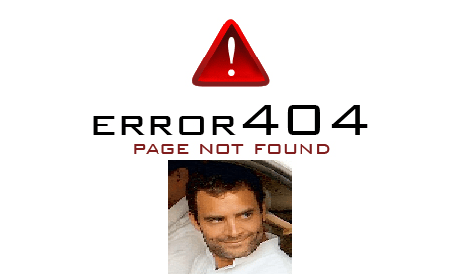
Unlike his tech.-friendly father, Rajiv, Rahul Gandhi has been slow to embrace technology. He doesn’t have a website and doesn’t use any of the three major social networks
Taking a leaf from US President Barack Obama’s presidential campaigns, India’s parties are using tools to crunch the insurmountable amounts of information social media generates – what’s known as big data analytics.
Pinstorm, a digital marketing agency used by some of India’s biggest companies to monitor what is being discussed online, now has political parties as clients.
From its Mumbai office, the agency has been collecting, storing and analysing tens of thousands of political statements from over 100 online platforms daily for the past six months to allow parties to find supporters and tweak their political message.
The agency is able to track conversations at national and local level, making it a useful tool for both national and regional parties.
The anti-corruption AAP, taking part in its first general election after an impressive debut in local polls in Delhi last year, uses Pinstorm to “compare how we are faring against others”, said Ankit Lal, the party’s social media strategist.
Professor Amit Sheth and a team of researchers at the Ohio Centre of Excellence in Knowledge-enabled Computing at Wright State University have also been tracking political sentiment online since July.
He says data collected from social media could in the future replace opinion polls, which many observers say are often rigged in India.
“With social media data, we can measure sentiments, for example, before a rally, during the rally, and post-analysis. It’s much more frequent [than opinion polls],” Mr Sheth said.
CONGRESS PLAYS CATCH-UP
While BJP is secure in its domination of the social media space and has started focusing on specialized electoral solutions, Congress has been trying to capture lost ground on social media. “We realized that a lot of BJP’s dominance is orchestrated and is a result of big spending online. Our approach is different. Ours is volunteer-driven and organic. And we encourage our volunteers to focus on positive messaging and to absolutely stay away from lies, half-truths and canards,” said Deepender Hooda, the two-time MP who is heading the party’s efforts on social media. Hooda’s social media cell has been organizing social media workshops.
“Now you will find that Congress-related hashtags trend more often because the geographical spread of our volunteers is very wide, from Agartala to Kanyakumari, unlike BJP’s, which comes from a few big cities,” Hooda said.
Short-term experiment or long-term strategy?
Indeed, some experts say it remains to be seen how successful these new campaign strategies will be in a country where nearly 70 percent of the population lives in rural areas, including millions of poor people.
“The importance of social media has grown, but look at the size of the population, the number of people living in villages, the number of illiterates,” said Sanjay Kumar, an election expert and director of the Center for the Study of Developing Societies.
The Congress party, a 128-year-old monolith dominated the Nehru-Gandhi family, has been slower to adopt new campaign tactics, with its organizers continuing to rely on such traditional methods as large-scale rallies and “road shows” in which candidates travel through villages waving from open cars.
The party’s public face, Rahul Gandhi, Jawaharlal Nehru’s great-grandson, is not active on social media. Recently, though, the party has tried to play catch-up to the Modi machine, redesigning its Web site and bringing in Matthew McGregor of the consulting firm Blue State Digital, who was dubbed Obama’s “digital attack dog” in the 2012 campaign. After a training session with McGregor in February, the Congress party introduced a “Fact Check” feature on the Web site to highlight some of Modi’s shortcomings and more controversial statements, according to Gaurav Pandhi, the head of the party’s volunteer social media effort.
“For far too long, the ‘India lives in its villages’ mind-set dominated political calculations and prevented parties from addressing urban voters,” Pandhi said. “But now urban India is hard to ignore.”
His words are telling. Rural votes filled the bread basket for the Congress Party. The fact that urban voters are being wooed is a sign that Congress is no longer confident of its rural base, and that even rural voters are becoming savvy.
All about turn-out
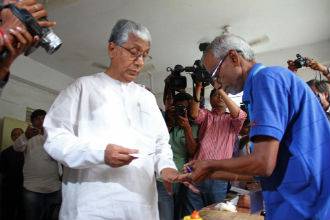
Tripura Chief Minister Manik Sarkar casts vote, Monday
Both the Congress and BJP need to get their vote out. Conventional wisdom though, suggests that a low turn-out would favor congress, and a high-turn-out would be good for the BJP. Higher voter turn-out is indicative of discontent, protest-voting, and so it also favors alternative parties such as the AAP.
After one day of voting, it appears that he electorate is electrified by the choices, this election. Voter turn-out is high, very high.
In Assam where 51 seats will be decided, voter turn-out was 72 percent translating representing the choice of around 65 million people, roughly twice the entire population of Canada.
Tezpur recorded 73 per cent voting, Jorhat 75 per cent, Lakhimpur 67, Dibrugarh 70 and Koliabor 72 per cent, the sources said. Observers and analytics suggest that first time voters, comprising the 18-21 age group came out came out in huge, perhaps decisive numbers to choose their representatives, no doubt buoyed by the activity and engagement on the internet and social media.
Eighty per cent voter turnout was registered in Tripura.
Numbers like this are unthinkable in the United States. India’s electorate is so vast and so diverse that it is hard to imagine the latest technology not being leveraged to understand and reach out to each and every segment of it. Consequently, it seems that digital campaigning or some future variant of it, is here to stay – that is as long as we’re logged in and not tuned out.
 The Global Calcuttan Magazine
The Global Calcuttan Magazine 
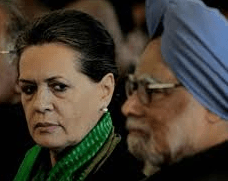
Great article, very informative!
Brilliant write-up.
Had no idea that Rahul doesn’t have a web-site or use social media – and this is right after Shashi Tharoor says no serious politician can avoid it – I guess that says a lot about Rahul Gandhi. Hilarious!
I have also noticed that this election is much quieter in Calcutta. I had wondered why. Great observation. Great article.
Nandan Nilekani thinks he’ll be to Rahul what Manmohan Singh was to Sonia. Huge miscalculation! Your party has to win first, sir!
P.V. Narasimha Rao’s legacy is being systematically dismantled by Sonia and the Party Chamchas. Now, they say it was all Rajiv’s idea (liberalization of 1990s). So why didn’t he do it? His policies were populist like his mother’s. Nehru Gandhi family will always play poor against rich/middle class, Muslim against Hindu, etc., they play the politics of division and keep people down because if people get educated, then wealthy, they’ll stop voting for an anti-democratic family!!!
I hope technology mitigates DNA. I’ll take an guy, who has had to fight his way though life in India over a Prince and his court jesters any time.
Notice that violence against women is absent from the cries of politicians. Deve Gowda defends Mulyalam – it’s sickening!
all these left parties can do is play politics of caste. they don’t care about women
We will have an article about how violence against women is being addressed or not addressed in the campaign. Thanks for your comments, and please keep reading! TGC
I am in Hooghly district, and will be voting for BJP..Mr. Chandan Mitra, a good journalist and capable man. I think it is unfortunate that Saurav didn’t run for BJP in Behala. Bengal needs to have a national party representing us Centrally. It is stupid to vote TMC or CPI(M)
I am a Muslim from Gujarat, and I will Vote for BJP. I have no great love for Modi but neither do I believe in Congress. They have ruled for almost all of the past 68 years, and have they done anything good for poor people, be they Muslim or otherwise? Everywhere people play politics of religion. Modi has helped the state improve economically. He will be better than any alternative.